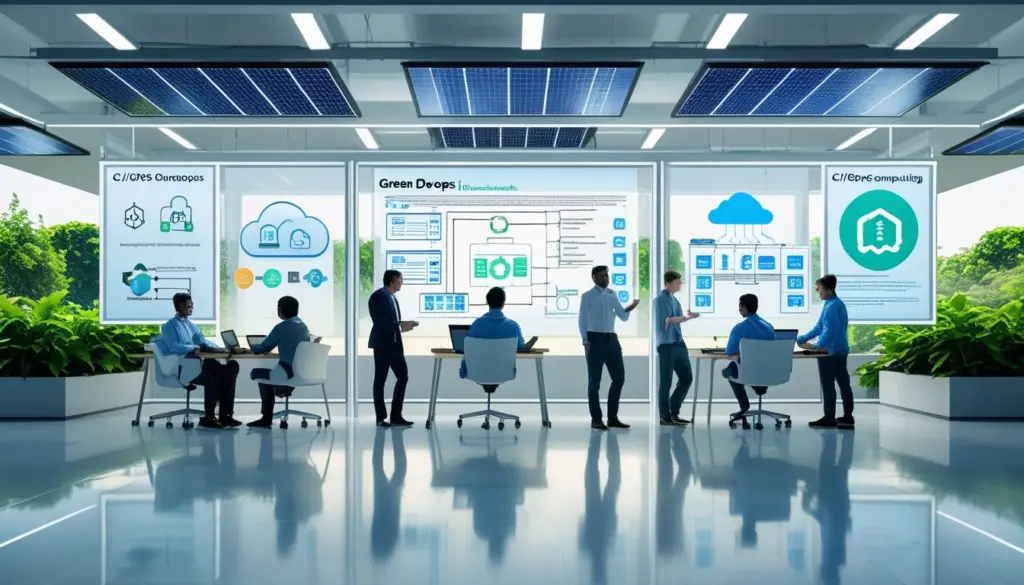Let’s be honest, DevOps is already quite a beast – right? CI/CD, automation, IaC, containers, AST, Cloud, orchestration, observability … half the time we’re just trying to keep production from crashing on a Friday evening 🫣. Now there’s growing buzz around something called Green DevOps popping up.
First reaction – Another buzzword, huh? 🤔 But hang on. This one actually makes sense, and it matters. 💡
See, in our race to push faster builds, scale up infra, and deploy like ninjas, we’ve kinda forgotten that all this tech: servers, data centers, networking runs on energy. And guess where most of that energy still comes from? Mostly from fossil fuels. 🔋 So every time we spin up 20 VMs for testing or leave our CI jobs running overnight… we’re unknowingly leaving a carbon trail.
Green DevOps is basically just DevOps – with a conscience. It’s about doing everything we already do, but with the environment in mind.
It’s not about making our lives harder – it’s about being a bit more thoughtful and intentional with the tools we already use.
In this blog, I’m gonna break down Green DevOps in super simple terms. No heavy jargon. No preaching. 😎 Just straight-up talk about:
- What does Green DevOps actually mean?
- Why it matters (especially for us in tech)?
- How we can start applying it, a step-by-step guide?
Whether you’re a DevOps engineer, SRE, Cloud architect, or someone who is tired of wasteful builds, this might just be the nudge you didn’t know you needed. So, let’s get started and make our workflows leaner, cleaner, and greener.
What Exactly Is Green DevOps?
Okay, so we’ve thrown around the term “Green DevOps” a bit, but what does it actually mean? Is it a new tool? A framework? Another thing recruiters will start asking in interviews? 😅
Not really. Green DevOps isn’t a specific tool or tech. It’s more of a mindset – a way of looking at our DevOps work through an environmental lens.
Green DevOps is a practical approach to making software development more sustainable by combining traditional DevOps practices with eco-friendly strategies. It helps reduce the environmental impact of our tech operations while maintaining high-quality software delivery.
And no, you don’t have to suddenly become an environmentalist 🤷 or give up your cloud setup. It’s about small, practical changes that can make a big impact. The beauty of Green DevOps is that it’s not about adding complexity – it’s about removing waste and working smarter.
Why Should We Even Care About Green DevOps?
Now some of you might be thinking – “Oh dear, we already have enough on our plate: deadlines, bugs, outages… and now we have to worry about climate change too?” 😅
Fair point. But here’s the thing – this isn’t just about the planet. It’s also about us, our work culture, and even our budgets. Let’s see how:

🌍 Our Industry Has a Huge Carbon Footprint
You might not see smoke coming out of your laptop, but make no mistake – our cloud builds, test environments, container clusters, etc … all of that consumes real energy.
And where there’s energy, there’s carbon – unless it’s 100% renewable (which, let’s be honest, is rare right now).
Just imagine: One inefficient CI pipeline that runs 100 times a day – that’s like keeping a bike engine running all day, every day. And now multiply that by thousands of teams across the world. Scary, no? 😨
💸 Green Practices Can Save Serious Money
Let’s talk money. Being green often means being lean.
- Fewer cloud resources = lower bills
- Optimized code = less resource usage = lower infra costs
- Better scheduling = smarter cloud pricing
A lot of startups and even big companies are realising that sustainability is not just about image anymore – it’s about efficiency.
✅ It’s Good Engineering Practice
Think about it, we always say:
“Write clean code. Avoid waste. Automate wisely.”
That’s exactly what Green DevOps is asking us to do, just with a little twist: “Do it in a way that’s also good for the environment.“
It’s like when our mom tells us to switch off the fan when we leave the room. Simple logic, right? Don’t waste what you don’t need. Same philosophy, just applied to DevOps.
What are the Key Components of Sustainable DevOps?

Sustainable DevOps isn’t just about turning off a few servers, it’s about rethinking how we build and run software. Let’s break down the key areas:
Green Software Engineering
This is where it all begins — write code that does more, using less.
The idea is simple: Less CPU time = less energy = fewer emissions.
Energy-Efficient Infrastructure
This is where most of the real energy savings happen. We often ignore infra once it’s running, but that’s where the real waste builds up.
Renewable Energy-Powered Cloud: Pick cloud regions and data centers that run on renewable energy (many providers share this info now).
Energy Efficiency: Use processors and machines that give more output for less power.
Resource Optimisation: No one likes a running fan in an empty room – same logic for infra. Auto-scale, right-size your VMs, and shut down what’s not in use.
Carbon Awareness: You can’t fix what you don’t measure. Start tracking the carbon cost of your deployments and environments.
Automation with a Conscience: Automate thoughtfully – don’t run multiple workflows unnecessarily (just in case). Make every pipeline count by keeping your processes lean and efficient.
Observability & Feedback: Keep an eye on what’s happening. Monitor Resource usage, Energy consumption, and Carbon metrics.
And most importantly, share it with other teams. Everyone should know where they stand.
How Do You Actually Do Green DevOps?
Okay, now comes the fun part. You don’t need to overhaul everything overnight. You can start small, just like we do with microservices: break it down, and tackle one part at a time. Here are some real-world, doable ideas:

💻 Green Coding: Write Code That Cares
It all starts with the code. Sustainable DevOps isn’t just about infra and automation – it’s also about writing software that’s efficient and energy-aware.
- Keep algorithms efficient – better time and space complexity = less CPU = less power consumption.
- Reduce memory usage – memory-hungry apps consume more energy. Be mindful of data structures and storage.
- Avoid unnecessary loops and calls – optimize logic, use short-circuiting, and memoization where needed.
Want a solid place to begin? Please follow 👉 Green coding is a matter of code quality
🧑💻 Test in Developer Space: Catch Issues Before They Fly Off
Why wait till deployment to know something’s broken? Just like you don’t serve guests without tasting the food, you shouldn’t commit code without proper local build and testing.
Use devcontainers or local Docker environments to keep things uniform across your team.
It’s like checking your homework before submitting it – better safe than sorry!
🏗️ Optimise Your CI/CD Pipelines
CI/CD is where most DevOps teams invest their time and where a lot of waste happens. Every unnecessary build, test, or deployment consumes CPU cycles and energy. Here’s what you can do:
- Run builds only when needed – skip builds for doc-only changes or tiny edits.
- Use build caching – save time and energy by avoiding redundant work.
- Parallelise smartly – more threads = faster, but don’t go overboard if you don’t need it.
- Clean up old artifacts regularly – junk files pile up and consume storage, so clear them out to save space and energy.
- Choose energy-efficient runners – use cloud or hardware options that are greener or powered by renewable energy where possible.
- Monitor pipeline run times and failures – failed builds waste energy. Fix flaky tests and optimize steps to avoid unnecessary re-runs.
- Automate pipeline triggers wisely – don’t trigger CI on every minor commit if it’s not needed; batch changes or use manual triggers for less critical work.
It’s like cooking. You don’t switch on all gas burners for making just a cup of tea, right? 😄 Same logic.
🌍 Go with Public Clouds That Think Green
These days, even cloud providers are getting smart about sustainability. They’re using carbon-aware computing to make sure workloads run in cleaner, greener ways. So if you are already on Cloud – do check their sustainability model.
Today, big cloud providers are moving toward carbon-aware computing, which basically means they run your workloads in locations or at times when clean energy is more available. Some platforms doing this already:
- ☁️ Google Cloud – Carbon-intelligent computing and region-wise energy impact
- ☁️ Microsoft Azure – Help build a clean-energy future and make progress toward your sustainability
- ☁️ AWS – Investing in renewable energy and offering carbon footprint tools
So next time you’re picking a cloud region or service, check if it’s climate-friendly. Your app doesn’t care where it runs, but the Earth surely does. 🌍
☁️ Clean Up Your Cloud Usage
Cloud infrastructure is like a buffet – super tempting to serve yourself more than you actually need. But remember, that extra compute costs money and power. 🤦 Here’s what you can do:
- Auto-shutdown idle dev/test environments – why keep them running when no one’s using them? Set timers, lambda, or schedules to shut down automatically.
- Use spot like instances, AWS Graviton-based Amazon EC2 instances (if AWS), or ARM-based processors – these options are less power-hungry and cheaper too. It’s like choosing the smaller plate when you don’t need a full meal.
- Set up alerts for underutilized resources – cloud providers often have built-in tools that tell you when machines are sitting idle. Don’t ignore those notifications!
- Right-size your instances – don’t keep big machines running if a smaller one will do.
- Clean up unused storage and snapshots – old backups, logs, and data can pile up like clutter. Regular cleanup saves both space and energy.
- Use managed services wisely – they often optimize resource use better than DIY setups, so lean on them where you can.
Think of it like cleaning your room – toss out what you don’t need, don’t hoard compute. 😅
🧪 Smarter Testing
Running every test every time? That’s like trying to memorize the entire textbook every night before exams – exhausting and unnecessary. Here’s how to be smarter with your testing:
- Run tests based on what’s changed – tools like
test --affectedhelp you focus only on the code that actually needs testing. - Use test impact analysis tools – helps to analyze which tests are relevant to your recent changes, helping you cut down the bloat in your test suite.
- Group tests by priority – critical, high-risk tests run on every commit; the full suite can run overnight or at specific milestones.
- Parallelize your tests – run multiple tests simultaneously to save time and energy, but avoid overloading your machines.
- Automate flaky test detection and quarantine – identify unstable tests that waste time and energy, and isolate them until fixed.
Imagine changing only one bulb in your house and then checking every single switch – that’s overkill. Smarter testing avoids that.
📦 Containerization & ⚖️ Auto-Scaling: The Dream Team for Sustainability
Think of containers like tiffin boxes – compact, self-contained, and consistent. Whether you’re deploying in Mumbai or Munich, your app behaves the same. That’s the power of containerization
Auto-scaling is like a smart AC that turns on or off depending on the temperature – it adjusts the number of running instances based on actual demand. So, when traffic drops, you’re not running 10 servers when you only need 2.
📏 Set Resource Limits: Don’t Let Your Infra Overeat Like It’s a Wedding Buffet
Left unchecked, your containers and VMs will gobble up CPU and RAM like there’s no tomorrow. That’s why setting proper resource limits is important. Here’s how you can do it:
- 🎯 Define
limitsandrequestsfor CPU, memory and other resources. - 🤖 Use autoscaling policies – scale up or down as per demand.
- 🔄 Review usage regularly – your app may evolve, so your limits should too.
It’s like having a food plan – eat what you need, don’t waste.
📦 Use Lightweight Containers & Images
Ever checked the size of your Docker images? Sometimes it’s like carrying a suitcase just for a pair of socks.
Please refer to this guide to learn more about best practices 👉 Image Optimization: A Deep Dive into Efficiency
Smaller images = faster deploys = less bandwidth and infra usage. Win-win.
📊 Track Your Carbon Footprint
This one is new for many teams 😅 – but it’s worth it. Some tools you can explore:
- Cloud Carbon Footprint (by Thoughtworks)
- AWS Customer Carbon Footprint Tool
- Microsoft Emissions Impact Dashboard
These tools show how your infra usage translates into actual carbon emissions – so you can take action where it matters.
👉 Think of it like checking your fitness tracker – once you see the numbers, you start making healthier choices.
🎯 Bonus: Make It Part of Team Culture
Finally, and this is important – Green DevOps is not just a tech tweak, it’s a mindset shift.
- Talk about it in retros and sprint planning
- Add “sustainability” as a non-functional requirement
- Celebrate small wins (like reducing build time by 20%)
Even if you start small – that’s okay. The point is to start.

Wrapping Up: Small Steps, Big Impact
Look, we all love fast builds, scalable infra, and seamless deployments. But if we can get all that and reduce our impact on the planet? That’s next-level DevOps.
Green DevOps is not about being perfect. It’s about being a little more mindful of the planet every day:
- Skip that extra build.
- Clean up unused infra.
- Choose better defaults.
- And keep your team in the loop.
Start with one thing. Maybe just auto-shutdown your dev VMs at night or trim your Docker images or optimize your CI pipeline, and so on.
Over time, all these small optimizations will stack up – just like compound interest for our lovely earth. 💸🌱
As the saying goes, “Little drops of water make a mighty ocean.”
So go ahead. Be that drop. 🌍💚


What a great article. Thanks for sharing details that are important to understand, analyze, monitor and improve things to deliver Sustainable Sustainable through right tools, practices and culture.
Green SW and Green DevOps means we can now IMPACT the planet in a POSITIVE manner.
Thank you so much, Kishore. Love how you put it — making a positive impact with the right tools, processes, and mindset is exactly the goal
As someone working in the Indian tech ecosystem, I find the idea of Green DevOps both timely and necessary. With India’s rapidly growing cloud adoption and increasing data center footprint, incorporating sustainable practices into DevOps isn’t just good for the planet—it’s essential for our future infrastructure resilience and cost-efficiency. Thanks for sharing.
Thank you, Srinivasan. Absolutely, India’s tech ecosystem has a real opportunity to lead with sustainable DevOps practices for both impact and innovation.